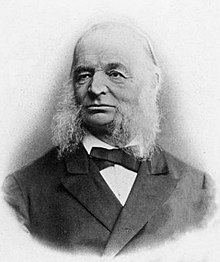奧托·威廉·馮·斯特魯維:修订间差异
(没有差异)
|
2012年4月1日 (日) 07:55的版本
| 此條目目前正依照其他维基百科上的内容进行翻译。 (2012年4月1日) |

奧托·威廉·馮·斯特魯維(德語:Otto Wilhelm von Struve,俄語:Отто Васильевич Струве,奧托·瓦西里耶維奇·斯特魯維,1819年5月7日—1905年4月14日)是一位俄羅斯帝國天文學家,波羅的海德國人。他和他的父親瓦西里·雅可夫列维奇·斯特鲁维都是19世紀著名的天文學家,並且曾在1862年到1889年之間擔任普尔科沃天文台台長,同時也是俄羅斯科學院院士。
早年生活
奧托於1819年生於俄羅斯帝國統治的多爾帕特(Dorpat,今愛沙尼亞塔爾圖),是瓦西里·雅可夫列維奇·斯特魯維和第一任妻子 Emilie Wall (1796年-1834年)所生8個子女排行第3。奧托於15歲就完成了當地文科中学的學業,但因為年齡過小無法進入大學就讀,但他仍獲准進入多爾帕特帝國大學旁聽,並於20歲完成所有大學課程。他在大學就讀期間同時也是父親在多爾帕特天文台的助手。他的大學學業於1839年結束後遷移到新成立於聖彼得堡附近的普爾科沃天文台,並成為台長(他的父親)的助手。因為他的初始天文觀測成果,他於1841年獲得了聖彼德堡大學頒發的天文學碩士學位。1842年他前往利佩茨克觀測日食,並於1843年獲得博士學位[1][2][3][4];同年並獲得俄國國籍[5]。
科學工作

During 1843 and 1844, Struve participated in longitude measurements between Altona, Greenwich and Pulkovo, which were based on large displacement of chronometers over the Earth surface. This newly developed method was adopted in Russia, and from 1844, the longitude was measured starting not from the Tartu Observatory but from the Pulkovo Observatory. Much of the 1844 Struve dedicated to studying the Sun. He deduced its apex coordinates and linear velocity as 7.3 km/s. Although it was significantly smaller than the correct value of 19.5 km/s measured in 1901, Struve's result was correct in that the velocity of the Sun was smaller than that of stars.[1][2][6][7]
Struve continued his father's work in several directions. In particular, they compiled famous Pulkovo catalogues of stellar coordinates, including several thousands double stars observed with a 15-inch refractor. Between 1816 and 1852, the observatory completed the famous survey triangulation measurements of the angular arc (named Struve Geodetic Arc). The measurements extended through over 2,820 km, from Hammerfest in Norway to the Staraya Nekrasovka village by the Black Sea, and aimed to establish the exact size and shape of the Earth. In 1851, while observing a solar eclipse, he came to a conclusion that solar corona and protuberances are physically connected with the Sun and are not an optical effect, as most of astronomers believed. Later in 1860 he suggested a close connection between solar protuberances and flares.[8] Struve also observed satellites of Uranus (Ariel and Umbriel, in 1851) and of Neptune. He also measured the rings of Saturn and discovered (in parallel with other researchers) the dark inner ring of Saturn. In 1861, in his report to the Academy of Sciences, he had supported and developed the ideas of William Herschel that stars are formed from the diffuse matter.[6][9] In 1872, Struve organized assistance with equipment to the newly opened observatory in Tashkent – a southern location offering clear skies for observations. In 1874, he prepared several expeditions to monitor the transit of Venus across the solar disk in eastern Asia, Caucasus, Persia and Egypt. In 1887, he sent several groups within Russia to observe the solar eclipse. In some of those expeditions, he took part personally.[4] In 1885, a 30-inch refracting telescope was installed at Pulkovo, at the time the largest in the world (see great refractor).
行政職務

Around 1845, von Struve's father withdrew from most management activities at the Pulkovo Observatory and focused on individual research. From then on, most of administrative duties fell on von Struve, especially in 1858 when his father was gravely ill. With his father's retirement in 1862, Otto officially became director and kept that position for 27 years until 1889. In the mid 1860s, the son's health deteriorated as well, to the point that neither he nor his physician hoped for recovery. However, instead of retiring, von Struve spent a full winter on leave in Italy and managed to restore his health.[4][10]
Struve remained a top authority at the Russian Academy and his requests, e.g. regarding staff appointments were always granted. The first refusal, in 1887, disappointed Struve so much that he applied for resignation and was stopped from that only by the Tsar Alexander III, who requested Struve to keep his posts until the 50th anniversary of the Pulkovo Observatory in 1889.[4]
For most of those years, the working language of the Pulkovo Observatory was German, as the staff members were largely foreigners. Struve had only limited command of Russian, yet he used it whenever possible.[4]
訪問美國
奧托是斯特魯維家族中第一位前往美國訪問的科學家(1879: New York, Chicago and San Francisco)。 The visit served several purposes, including ordering the Alvan Clark & Sons optics for the new 30-inch telescope in Pulkovo,[11] and it was a part of long-term Russia-US astronomy partnership during the 19th century. Within that collaboration, many American astronomers stayed at Pulkovo for observations and exchanged data with Russian scientists by mail. By the initiative of Struve, two US astronomers, Simon Newcomb and Asaph Hall were appointed as Foreign Members of the Russian Academy of Sciences.[2]
個人生活與晚年

奧托曾結婚兩次。第一次婚姻是和一位德裔女性 Emilie Dyrssen(1823年-1868年),兩人育有4子2女活到成年。第一任妻子去世後數年,奧托和 Emma Jankowsky(1839年-1920年)結婚並育有2女。奧托的兩個幼子赫爾曼·斯特魯維和路德維希·斯特魯維繼承了家族傳統並成為著名的天文學家。兩個較年長兒子分別是俄羅斯帝國財政部官員和地質學家。奧托於1889年退休後大多數時間都留在聖彼得堡整理觀測資料和維持學術研究,有時候到瑞士和義大利旅行。1895年在德國旅遊期間因為身體不適而留在德國,1905年在卡尔斯鲁厄逝世[4]。
榮譽與獎項
奧托因為他在1840年出版的《The Determination of the Constant of Precession with respect to the Proper Motion of the Solar System》,於1850年獲得英國皇家天文學會金質獎章[7][12]。他是瑞典皇家科学院院士。1852到1859年之間奧托是俄羅斯科學院成員,並於1856年獲選為該院院士。小行星768是用來表彰他和斯特魯維家族的另外兩位天文學家瓦西里·雅可夫列維奇·斯特魯維和赫爾曼·斯特魯維。[13];月球上的斯特魯維環形山則是表彰他和家族中另兩位天文學家瓦西里·雅可夫列維奇·斯特魯維和奧托·斯特魯維。斯特鲁维测地弧於2005年獲選為世界遺產[14]。
參考資料
- ^ 1.0 1.1 Otto Vasilevich Struve (in Russian)
- ^ 2.0 2.1 2.2 Отто Васильевич Струве (in Russian)
- ^ Nyren, M. Otto Wilhelm Struve. Popular Astronomy. 1906, 14: 352. Bibcode:1906PA.....14..352N.
- ^ 4.0 4.1 4.2 4.3 4.4 4.5 Nyren, M. Otto Wilhelm Struve. Publications of the Astronomical Society of the Pacific. 1905, 17: 99. Bibcode:1905PASP...17...96N. doi:10.1086/121632.
- ^ Batten, Alan Henry. Resolute and undertaking characters: the lives of Wilhelm and Otto Struve. Springer. Springer: 135. ISBN 978-90-277-2652-0.
- ^ 6.0 6.1 Astronomy dates and discoveries, chapter 9. astro.websib.ru (Russian).
- ^ 7.0 7.1 Dr. Otto Von Struve. Nature. 1905, 72 (1855): 61. doi:10.1038/072061a0.
- ^ Artemenko, T. G.; Balyshev, M. A.; Vavilova, I. B. The struve dynasty in the history of astronomy in Ukraine. Kinematics and Physics of Celestial Bodies. 2009, 25 (3): 153. Bibcode:2009KPCB...25..153A. doi:10.3103/S0884591309030040.
- ^ V. K. Abalkin et al. Struve dynasty (in Russian), St. Petersburg University
- ^ Newcomb, Simon. Sketch of Professor Otto Wilhelm Struve. The Popular Science Monthly. 1880, 17 (June): 263–264.
- ^ Donald E. Osterbrock. Yerkes Observatory, 1892-1950: the birth, near death, and resurrection of a scientific research institution. University of Chicago Press. 1997: 77. ISBN 0-226-63946-0.
- ^ Astronomy and the Struve Family. Nature. 1944, 154 (3902): 206. Bibcode:1944Natur.154Q.206.. doi:10.1038/154206a0.
- ^ Lutz D. Schmadel. Dictionary of minor planet names. Springer. 2003: 73. ISBN 3-540-00238-3.
- ^ Struve Geodetic Arc, UNESCO
延伸閱讀
- Nyren, M. Otto Wilhelm Struve. Popular Astronomy. 1906, 14: 352–368. Bibcode:1906PA.....14..352N.
